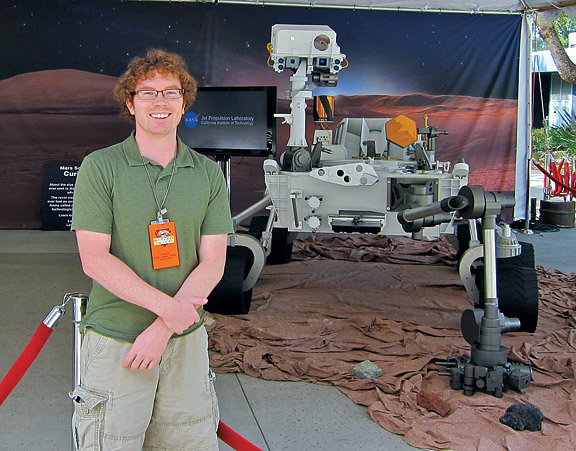When a NASA official announced in the early hours of August 6 that the
Mars Science Laboratory rover Curiosity had landed safely on Mars, the
engineers at Mission Control in Pasadena, California, hugged and
cheered. So did the science team, which included Assistant Professor of
Geological Sciences Ralph Milliken ’03 ScM, ’06 PhD. Since then,
Milliken has been busy helping determine exactly what the rover has
been doing. The goal is to study the rocks and soils of Gale Crater,
producing data that will, over the years, help scientists like Milliken
understand the geological history of the planet. Before the landing,
Milliken discussed his role with Brown science writer David Orenstein.

What has your role been?
As part of the science team, I’ll work with everyone else to look at
the data, determine which instruments we want to use and for which
purpose, which rock we might want to drill into, and make the case for
the day-to-day science operations within the overall strategy to make
sure the rover is accomplishing the mission’s goals.
What do you hope the mission will tell us about Mars?
In the grandest sense I want the mission to tell us more and something
new about the geological history of Mars. The Curiosity rover is not
strictly a life-detection mission. It is a mission that’s designed to
go to a place on Mars and provide us information to be able to
determine if that place had the right ingredients to be habitable for
life. It has the capability to detect organic material if it happens to
be present in the rocks or soil.
What questions are you asking?
The evidence suggests that Mars may have been warmer and wetter 4 to
4.5 billion years ago. Today it is a very cold and arid environment.
That transition from wetter and warmer to colder and drier, from what
we understand, probably happened about 3 to 3.5 billion years ago. The
question is, why did that happen? Why did Mars take a different
evolutionary pathway than Earth? What does such a drastic change on a
global scale imply about the possibility of life on ancient Mars?
How is the rover equipped to help answer those questions?
The rover has a ton of different cameras. Some of them are for hazard
avoidance and navigation, but there is a more sophisticated camera
system on the mast of the rover that will be able to do 360-degree
panoramas at a number of different wavelengths of light. That gives us
the color images we can use to assess the local geology and search for
variations in the minerals that are present.
It also has an instrument called ChemCam that shoots a laser at rock or soil targets and vaporizes them. We can look at the plasma that is created in this process and identify the chemical signatures of the rocks and soils that have been zapped by the laser, so this is one of our primary remote sensing tools for determining which rocks we might want to drive up to for additional analyses.
There is also a meteorology instrument on the rover that can tell us about the daily weather, including temperature, winds speeds, humidity, and atmospheric pressure.
The rover can actually go up to rocks, drill into them or scoop up
the soil it’s driving over. It can take that rock or soil, crush it up,
and pass it to instruments on the body of the rover.
How long will the mission last and how are you adapting to Mars time?
The primary mission is for one Mars year, which is nearly two Earth
years. We hope that if things are going well it will keep getting
extended. During the first ninety days, or ninety sols as we call them
on Mars, we’ll actually live on Martian time. I haven’t lived on Mars
time before but I know people who have done it for the other rovers. It
can be quite disorienting. Blackout shades and curtains in your
apartment are a must.




